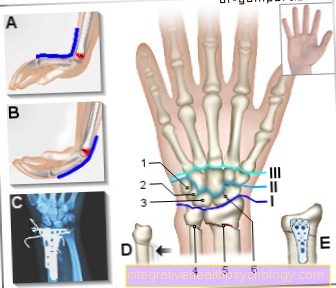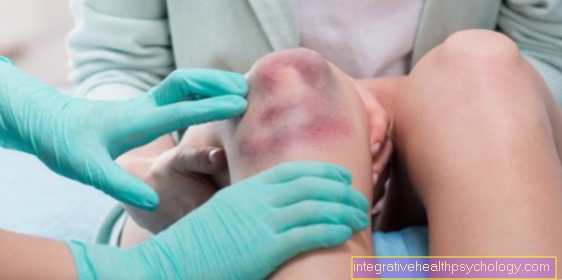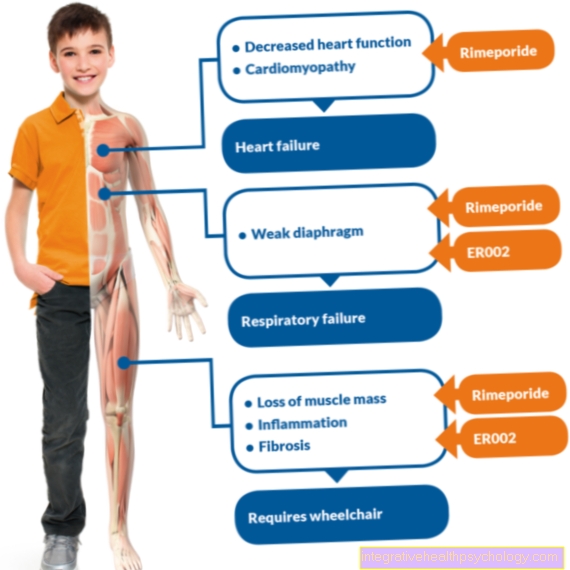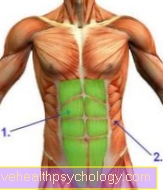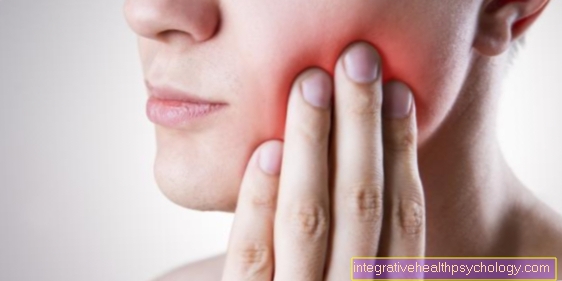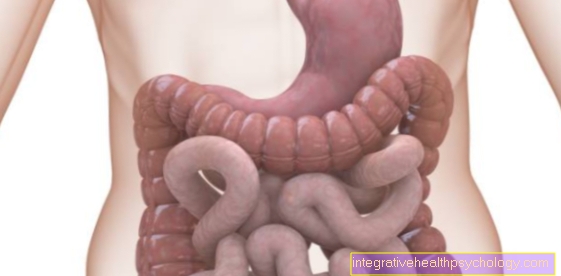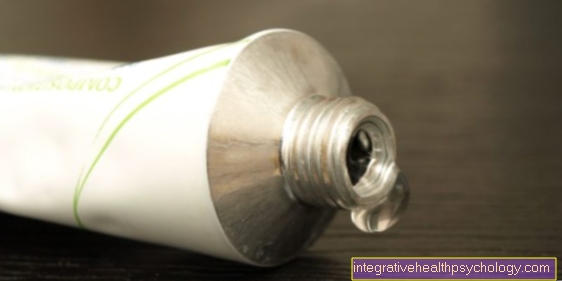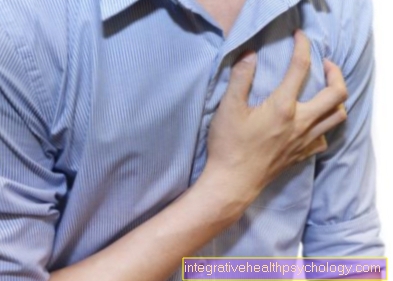Vomiting of bile
definition
Vomiting from bile is also known as Cholemesis designated. In the narrower sense, it is only about vomiting of what is formed in the liver Bile. In popular parlance, however, it is often understood as vomiting of stomach contents which no longer contain any visible food residues. Strictly speaking, however, this is not bilious vomiting. The color of the bile varies from yellowish to greenish. Heavily thickened bile can also take on a brownish tone.
Please also read our article on this Bile per se.

causes
The cause of bilious vomiting usually lies in one Intestinal obstruction in the area of the small intestine. Such an occlusion can cause the bile to back up.
Please also read our article on this Symptoms of an intestinal obstruction
There are various possible causes for the intestinal obstruction, such as tumors that obstruct the intestinal passage. Even bigger ones Gallstones can become an obstacle to passage and thus lead to occlusions, which are particularly located at the transition from the small intestine to the large intestine.
Through the closure it can become a Backwater come from intestinal contents and bile. This back pressure, in turn, can manifest itself in bilious vomiting. The color of the vomiting varies from yellowish-greenish to darker brown tones.
Also other causes like foreign body or Scarring in the small intestine, for example after operations, can lead to constrictions, so that the intestinal contents and the bile are backed up. Vomiting real bile should not be confused with vomiting stomach contents. Frequent reasons for this are the backflow of stomach contents ("Reflux") or vomiting very often, for example with gastrointestinal flu.
Bilious vomiting after drinking alcohol

Alcohol can have a harmful effect on the liver, causing damage and secondary diseases such as one Cirrhosis of the liver or alcoholic liver damage.
Other conditions such as chronic inflammation of the pancreas (Pancreatitis) or complaints of the esophagus and stomach can arise especially after long-term regular alcohol consumption.
The vomiting of bile itself causes alcohol consumption Not directly. However, most illnesses, such as chronic pancreatitis or alcoholic liver damage, are associated with nausea and vomiting. Since food intake is mostly neglected, especially when there is a very high level of alcohol consumption, frequent vomiting leads to vomiting of "empty" stomach contents, i.e. only gastric fluid, which is mistaken for bile.
Vomiting of bile after bowel surgery
The bile is produced in the liver and from there reaches the intestine via the gall bladder, where it is mainly responsible for digesting fat. The bile then passes through the digestive tract and is excreted in the stool. After an intestinal operation, this passage of food through the intestine is often still disturbed, but normally there should not be vomiting of intestinal contents and thus also of bile. Often, however, the bowel is still very sluggish after an intestinal operation. This leads to a build-up of intestinal contents and bile. In the case of a strong build-up, bile can also get into the stomach and be vomited from there.
You might also be interested in this topic: Postoperative intestinal atony
Symptoms
Concomitant symptoms of vomiting of bile can point to the causal clinical picture or to additional, accompanying clinical pictures. At a Small intestine obstruction, which can lead to bilious vomiting strongest pain very typical in the area of the abdomen. Furthermore, nausea, stool and wind retention and cramp-like pain can occur.
Concomitant diseases of the Gallbladder like gallstones or inflammation of the gallbladder can be too right upper abdominal pain lead that into the shoulder radiate.
Please also read our article on this Gallbladder pain
Diarrhea with bilious vomiting
Diarrhea is more likely not a typical accompanying symptom with real, bilious vomiting. Mostly, an obstruction of the intestine is the cause of the vomiting. Such an intestinal obstruction would, however, result in stool retention rather than diarrhea. In the course of a gastrointestinal infection, which is accompanied by severe vomiting and diarrhea, vomiting of "empty", thin-bodied stomach contents can occur.
Fever with bilious vomiting
Fever is a possible accompanying symptom. It can be on a systemic inflammation or one infection Clues. If the gallbladder is also inflamed, a fever can occur, for example. Also with diseases of the liver, such as alcohol-toxic liver damage or a hepatitis, the temperature may rise.
Pain with bilious vomiting
Bilious vomiting can be a symptom of many diseases. For example, the bile builds up in the stomach when the food cannot be transported further in the intestine. This can lead to non-specific abdominal pain and vomiting of bile. Excessive production of bile acids, gallbladder disease and gallstones can also cause bile vomiting. This often leads to colicky pain in the right upper abdomen. These can also radiate into the right shoulder.
Bilious vomiting with blood
Vomiting bloody may indicate various comorbidities. Bright red Blood in the vomit may be for Tears in the mucous membrane in the esophagus (the so-called Mallory-Weiss Syndrome) or in mouth speak, which also occur frequently with chronic alcohol consumption.
In general, vomiting blood is (Hematemesis) an indication of bleeding in the upper Digestive tract, which includes the esophagus, stomach and duodenum. Also Tumors in the duodenum or in the stomach can lead to blood in the vomit. Tumors of the duodenum, which, for example, lead to a blockage in the intestine and bleeding, as well as a build-up of bile, can be a reason for bilious vomiting with blood.
Read our article on this: Vomiting blood
Heartburn with bilious vomiting
Heartburn is typically a symptom of stomach acid flowing back into the esophagus (Reflux). The high acid content leads to burning pain in the esophagus. These are usually felt immediately behind the chest. Heartburn is particularly pronounced after large meals. Heartburn can also occur when lying down. If heartburn occurs in connection with vomiting of bile, this indicates that intestinal contents are returning from the duodenum to the stomach and from there into the esophagus.
You might also be interested in this topic: Causes of heartburn
Color of the vomit
The color of the bile comes from that contained in it Bile pigments conditions. These arise among other things as breakdown products of the blood pigment (hemoglobin) and other so-called porphyrins, which are also contained in vitamin B12, for example. The main part of the coloring do the so-called Bilirubin as well as that Biliverdin out. Depending on the composition, the color varies between a yellowish and a more greenish tone. As a result, vomited bile can vary in color.
What to do if you vomit bile?
What should I do with bilious vomiting?
If you vomit, it is advisable to keep calm first. If you are in a stable physical condition, you can visit your general practitioner and explain your symptoms to him in peace. Explain exactly what the vomit looks like, what color it is, whether there was nausea or whether there was a certain triggering event for the vomiting, for example a special food intake.
You should also describe possible accompanying symptoms such as fever, pain or the like as precisely as possible. Your previous illnesses or medication intake are also important and need to be discussed.
Do not consume luxury foods such as alcohol or nicotine if you experience such complaints, as this can worsen the clinical picture. You should also take care of yourself and make sure you drink enough.
If you vomit like a gush for no apparent reason or if you vomit with large amounts of blood, if your circulation is unstable or if you have also suffered a loss of consciousness or the like, an emergency room should be visited.
How do you calm the stomach?
Bile is a liquid that, under normal circumstances, enters the intestine directly and therefore does not come into contact with the stomach. However, a build-up in the intestine can cause the bile to flow back into the stomach. This is irritated, so that nausea and sometimes bilious vomiting are the result. In such cases, the stomach can first be calmed down by avoiding fatty foods. In addition, food that is gentle on the stomach should generally be consumed and plenty of fluids to drink. A hot water bottle and physical rest can calm the stomach again. If bile and stomach problems persist, a doctor should be consulted who can find the cause of the symptoms and initiate suitable therapy (for example with medication).
Can you vomit bile without a gallbladder?
Anatomically speaking, the gallbladder is used to store bile that is produced in the liver. From there it is released into the gastrointestinal tract in a controlled manner. This happens especially during and after the consumption of particularly fatty foods, as the bile is required for the digestion of fats. After the gallbladder is removed, the liver continues to produce bile. However, this is no longer temporarily stored, but reaches the digestive tract directly. From there it usually goes through the intestines and is eliminated in the stool. However, due to various causes, the contents of the intestine may vomit; even after the gallbladder has been removed, these still contain bile, which can also be vomited.
Vomiting of bile during pregnancy
Pregnant women are often plagued by nausea and vomiting early in their pregnancy. About 0.5 to 1% of women have severe courses of vomiting (Hyperemesis gravidarum). This refers to the insatiable pregnancy sickness.
The mild form is called vomiting gravidarum and affects many women. It occurs mainly in the first 3 months of pregnancy and usually subsides by the 20th week of pregnancy.
Pregnant women vomit very often, even when the stomach is empty, which is why it is often said that they vomit "until the bile comes". However, it is mostly just stomach contents and not bile.
Read our article on this: Vomiting during pregnancy
diagnosis
Your doctor, for example your general practitioner or a treating internist, can narrow down the causes of bilious vomiting by specifically asking (anamnesis) about important accompanying symptoms or living conditions. So will after Pre-existing illness in the small intestine, liver, gallbladder and other organ systems. Likewise the Alcohol consumption as well as the regular intake of Medication he asks.
After a physical examination, which includes an examination of the abdomen with a special examination of the liver and gall bladder, a sample of the vomit can also provide information about the cause. If it looks yellowish, greenish, it suggests that it is bile.
Imaging tests, such as a Ultrasound examination of the abdomen or a Gastroscopy, then join to rule out diseases of the gastrointestinal tract such as the liver and gallbladder. To rule out an intestinal obstruction, a X-ray image of the abdomen in the left lateral position and while standing. This is where the typical "fluid level build-up" in an intestinal obstruction would appear.
What evidence is there that it is cancer?
Basically, bilious vomiting can indicate various types of cancer in the digestive tract or the biliary tract. Various mechanisms (increased bile production, clogging of the bile ducts, clogging of the gastrointestinal passage) can lead to vomiting of bile as a result of the tumor. Typically, additional symptoms such as fever, night sweats (night sweats so that clothes and bed linen have to be changed) and unwanted weight loss (over 10% of body weight within 6 months) occur. It can also lead to non-specific digestive problems.
You might also be interested in the following topics: Gallbladder cancer and bile duct cancer
Duration
The length of time it takes for you to vomit bile depends on the underlying cause. A bowel obstruction can be a very acute event that develops within a few hours, but it can also be a gradual condition that develops within a few days.
Vomiting can persist for a few days before therapy is given. As a rule, however, a rapid medical clarification take place when you vomit biliously so that vomiting stops quickly. States like Reflux disease or Inflammation of the gastric mucosawhich are also accompanied by vomiting, which is often popularly referred to as "bilious vomiting", can occur for months or even years. However, it is not actually vomiting of bile.






